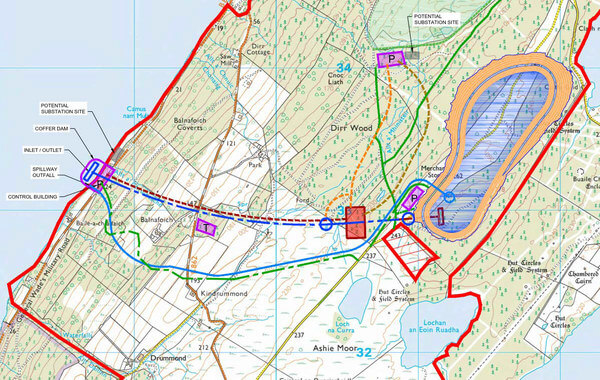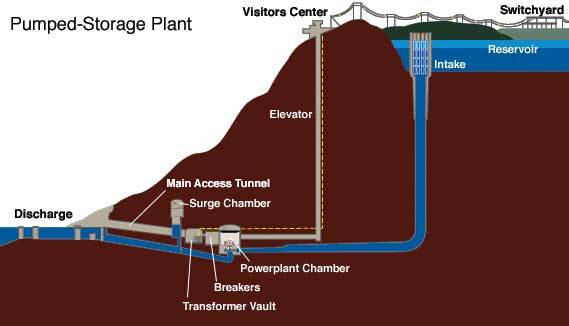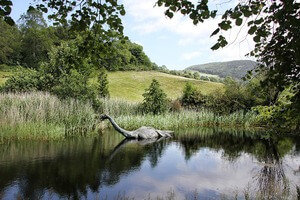News Release from windfair.net
Wind Industry Profile of
Wind Power for Nessie?
The obvious answer to this question is - save it. However, what works well on a small scale with batteries looks completely different on an industrial one. A powerhouse for the production of renewable energy in Europe is Great Britain as well as Germany. The British strength lies, above all, in offshore wind, but they are also asking what to do with the energy in slack times.
The Intelligent Land Investments Group (ILI Group) has presented a spectacular idea: An over production of wind power is to be stored in the famous Loch Ness. This would require a pumped storage power plant with a capacity of 400 megawatts to be built on site. The power plant, given the name 'Red John', is to pump water between Loch Ness and a newly constructed upper pond that uses the natural topography between Loch Duntelchaig, Loch Ashie, Loch na Curra and Lochan on Eoin Ruadha.
The basic idea is not new, because Loch Ness is already being used as the lower storage basin for the pumped storage power station of the waterfall on the river Foyers, which was the first of its kind in Great Britain at the time. The turbines were originally used to supply energy to a nearby aluminium smelter. Today, electricity is generated there and supplied to the national grid. Another pumped storage power plant is located near Fort Augustus and has a capacity of 100 MW.
But none of these projects reach similar dimensions as Red John. Mark Wilson, CEO of ILI, emphasises the benefits: “Renewable energy capacity in Scotland has more than doubled since 2007, but due to its intermittent nature there is a need to store surplus energy from sources such as wind so it can be used when we need it most. Pumped storage hydro is the largest and cleanest form of energy storage that currently exists – and a key enabler in helping Scotland meet its green energy ambitions. As well as dramatically improving our energy security, this transformational proposal is a fantastic opportunity for the community to benefit from the energy transition while helping turbo-charge Scotland’s decarbonisation efforts.”

A construction project with huge dimensions (Map: Intelligent Land Investments Group)
The company expects the construction phase to create between 200 and 300 new jobs and Red John to provide 2.4 GWh of storage capacity for the network over a period of six hours after completion. This amount of energy can supply 400,000 houses with electricity for up to an hour.
ILI will use electricity to pump water from Loch Ness into the reservoir in the mountains above the lake. This happens when more energy is produced than needed - for example at night. This energy is stored until it is needed. For this purpose, the water is led back down through a water turbine. This is how electricity is generated for sudden or predicted peaks in demand.

Diagram of the TVA pumped storage facility at Raccoon Mountain Pumped-Storage Plant (Image: TVA , Public Domain)
A typical conventional pumped storage power plant consists of four components, as explained on the website of the Red John project:
- Water reservoirs: normally two interconnected water reservoirs
- Water pipes: tunnels to transfer water from one reservoir to another
- Power plant: plant with one or more pump/turbine and motor/generator units which allow water to be pumped into the upper reservoir and discharged into the lower reservoir at peak times
- Grid connection: power transmission lines to bring the generated electricity from the plant into the grid
At present though, the project still has a long way to go. Environmental measurements are currently being carried out on site. Neighbouring communities are being interviewed to determine the approval rate for such a large project, especially as the construction work alone is likely to take years.
 However, the first ideas of offshore wind power were tiredly smiled at and dismissed as a spinning mill. Today - not far from Loch Ness - several hundred wind turbines are rotating in the Morey Firth. Others will follow, as the Beatrice offshore wind farm is currently being built there. Scotland is therefore familiar with large-scale construction projects.
However, the first ideas of offshore wind power were tiredly smiled at and dismissed as a spinning mill. Today - not far from Loch Ness - several hundred wind turbines are rotating in the Morey Firth. Others will follow, as the Beatrice offshore wind farm is currently being built there. Scotland is therefore familiar with large-scale construction projects.
Whether the project in this form can really be realized, however, must be waited for, particularly since the construction of an artificial lake would represent a considerable intervention in the landscape.
On the other hand, if Nessie doesn't mind, why not?
(Image of Nessie: Pixabay)
- Author:
- Katrin Radtke
- Email:
- press@windfair.net
- Keywords:
- Red John, ILI Group, Scotland, UK, offshore, wind energy, pump, storage, hydro, Loch Ness, Nessie






















